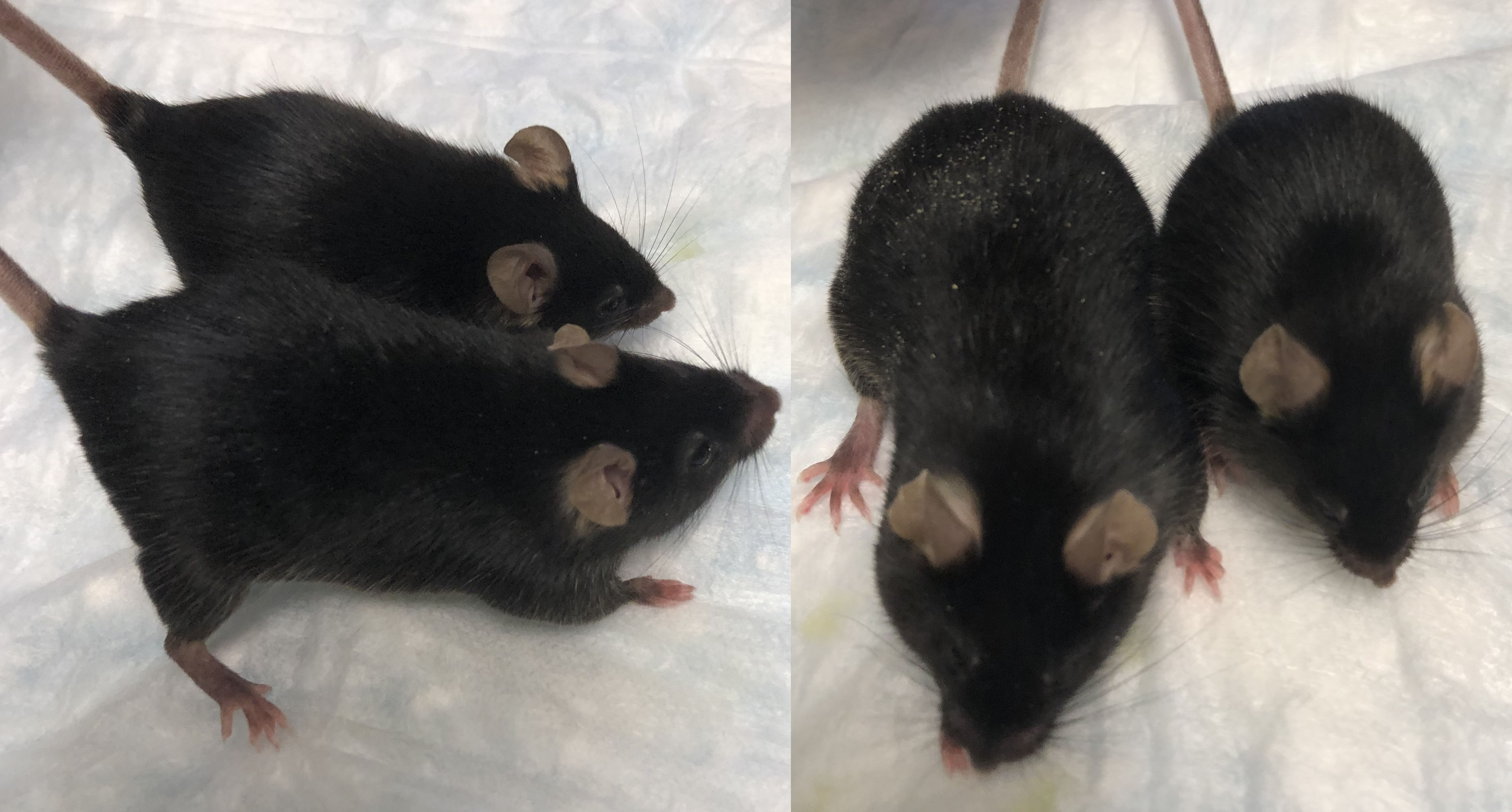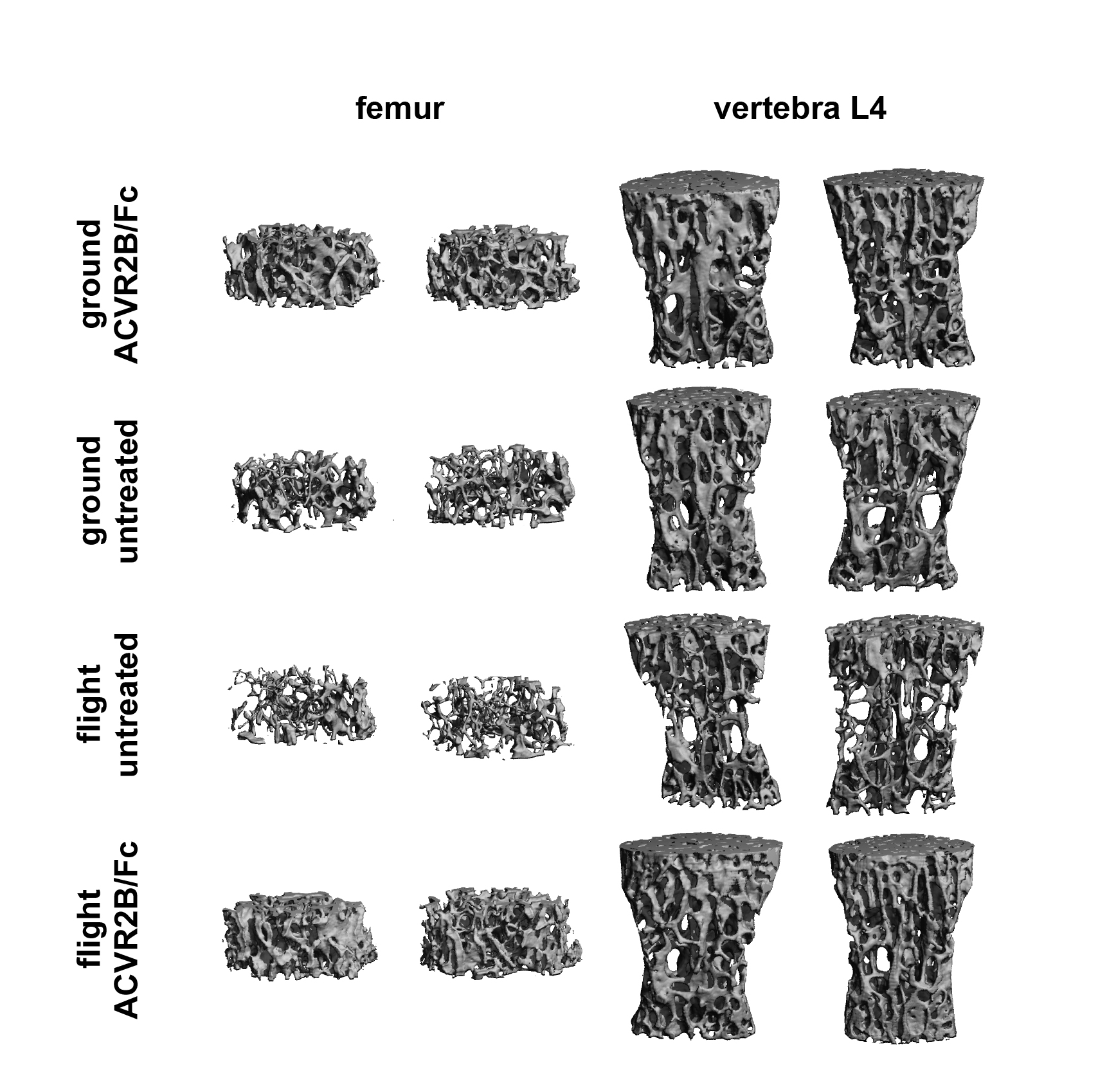Buff space mice could stop astronauts from losing bone and muscle mass

Super-muscular mice may now reveal a way to keep astronauts from losing muscle and bone in the microgravity of space, a new study finds.
A major challenge astronauts face during prolonged space missions is the simultaneous loss of bone and muscle, which weaken and atrophy due to disuse outside the constant pull of Earth's gravity. Previous research found that in microgravity, astronauts can lose up to 20% of their muscle mass in less than two weeks.
The husband-and-wife team of Se-Jin Lee and Emily Germain-Lee thought they might have found a way to fight bone and muscle loss when Lee and his colleagues at Johns Hopkins University helped discover myostatin, a protein that normally limits muscle growth, in the 1990s.
Related: The human body in space: 6 weird facts
"Back then, we showed that mice in which we deleted the myostatin gene had dramatic increases in muscle mass throughout the body, with individual muscles growing to about twice the normal size," Lee, a geneticist now at the Jackson Laboratory for Genomic Medicine in Farmington, Connecticut, told Space.com. "This immediately suggested the possibility that blocking myostatin might be an effective strategy to combat muscle loss due to a wide range of diseases. This also suggested the possibility that this might be effective for astronauts during extended space travel."
For the past 20 years, the researchers have wanted to see what effects blocking myostatin would have in mice sent to space. "We finally got the opportunity to do so last year," Lee said.
In December, the scientists launched 40 mice from NASA's Kennedy Space Center to the International Space Station aboard SpaceX's CRS-19 cargo resupply services mission. "We were so impressed by the dedication, focus and enthusiasm that everyone brought to this project, and it was a privilege to have the opportunity to work with all of them," Lee said.
Get the Space.com Newsletter
Breaking space news, the latest updates on rocket launches, skywatching events and more!
Related: How spacefaring rodents adapt to life in space (video)
While 24 of the 40 mice were normal, eight of them were missing the myostatin gene and eight others were treated with a molecule that suppressed both myostatin and a protein known as activin A, which has similar effects on muscle as myostatin.
Normal mice — those that carried the myostatin gene and received no protein-inhibiting treatments — lost significant muscle and bone mass during the 33 days spent in microgravity. In contrast, mice that were missing the myostatin gene and had a muscle mass about twice that of a regular mouse, largely retained their muscles during spaceflight.

In addition, the scientists found the mice that received the molecule suppressing myostatin and activin A saw dramatic increases in both muscle and bone mass. Moreover, mice treated with this molecule after returning to Earth experienced more recovery of muscle and bone mass when compared with untreated mice.
These findings suggest targeting myostatin and activin A "could be an effective therapeutic strategy to mitigate muscle and bone loss that occur in astronauts during extended spaceflight, as well as in people on Earth who suffer from disuse atrophy as a result of being bedridden, wheelchair-bound or elderly," Germain-Lee, a pediatric endocrinologist at the University of Connecticut School of Medicine in Farmington, told Space.com.
Related: Space travel causes joint problems in mice. But, what about humans?
Although the researchers find their results exciting, "It is important to remember that these studies were done using mice," Lee said. "Although mice have very similar physiology to humans, sometimes what we learn from mice does not translate exactly to humans. There is still a lot of work that would need to be done to develop treatments for humans, but we believe that this type of strategy holds great promise."
Lee, Germain-Lee and their colleagues detailed their findings online Sept. 7 in the journal Proceedings of the National Academy of Sciences.
Follow Charles Q. Choi on Twitter @cqchoi. Follow us on Twitter @Spacedotcom and on Facebook.
Join our Space Forums to keep talking space on the latest missions, night sky and more! And if you have a news tip, correction or comment, let us know at: community@space.com.

Charles Q. Choi is a contributing writer for Space.com and Live Science. He covers all things human origins and astronomy as well as physics, animals and general science topics. Charles has a Master of Arts degree from the University of Missouri-Columbia, School of Journalism and a Bachelor of Arts degree from the University of South Florida. Charles has visited every continent on Earth, drinking rancid yak butter tea in Lhasa, snorkeling with sea lions in the Galapagos and even climbing an iceberg in Antarctica. Visit him at http://www.sciwriter.us
-
d3bug I am seriously disappointed you didn't have an artist make a render of "Buff Space Mice" with six pack abs... :)Reply -
kristianna276 No matter how you throw the dice, it all ways comes up snake eyes. In order for humans to exist in space we need all the things humans need to survive. Air, food, water protection against radiation, and gravity. In order to inhabit a ship large enough to produce gravity, we need really large spaceships, This mega ships can only be manufactured in the environment of space. That means we need to build shipyards to do R&D and build these future transport systems. We have shipyards on Earth; we need shipyards in space. Can we build the Arnold Schwarzenegger that would be super buffed to be future astronauts? Wow! A whole army of human terminators. It would like He-Man and the Masters of the Universe. It would be better than Roger Ramjet. I feel I am about to faint.Reply -
DrRaviSharma Comment Author Dr. Ravi Sharma also submitted a proposal as Principal Investigator with overall title: “Microgravity, Developmental Biology & Genetics” and specific subject: “Mammal Survivability, Genetic Adaptation & Species Evolution In Microgravity Long Duration Missions”, in response to NASA Gravitational Biology and Biomedical Research and Countermeasures Programs Research Announcement NRA-96-HEDS-04 Dated Dec 27, 1996, on 31 March 1997 from Hughes STX Corporation (97-OMG-150). https://taskbook.nasaprs.com/peer_review/nra/old/96_HEDS_04.html. The proposal was to study 60 successive generations of Rodents over 10 years period on Space Station, with in-depth comparative bioinformatics on genetic and physiological performance in, adaptation to microgravity, with several generations returned to Earth for comparison with samples of 60 Generations on Earth. An elaborate databased information system would keep track of any indicators of mutation, genetic changes, reproduction and repair aspects. NASA found proposal useful but elaborate Lab required was not funded. Subsequently various elements of similar studies have been carried out on ISS which are referenced throughout. Author has been also active in microgravity effects on Human life. <<Personal information removed by moderator. Never post your email address.>>Reply -
kristianna276 I would like to know what happens to the human physiology when there is no microgravity present, and the body is between planets, like being between the Earth and Mars? Do we have simulations of what would happen? How far does microgravity extend till there is no gravity? How many will have to die for us to find out?Reply -
DrRaviSharma KristiannaReply
The extent or strength of microgravity felt in space depends on the other gravity carrying matter around the spacecraft and also if there are relative movements of matter and people. the points in orbit where e.g. gravity between earth and mars equals are like lagrangian points where if other factors are neglected and no thrusters are fired, the space craft can stay there for long periods, reality has other perturbations and microgravity effects.
For long duration missions spinning stations have been proposed to create artificial gravity so the physiology mimics earth experience and people are likely to stay healthy.
Solar study satellites form NASA and ISRO use the Lagrangian points to keep looking at the SUN.
As in above post I also proposed 22 years ago for the ISS an expoeriment to measure microgravity effect of particles and their random movements in a balloon fixed with micro imaging systems to record these movements. After 20 years of that proposal hundreds of experiments on ISS have provided that type of data as well as effect of microgravity in varous phases of matter Solid, Liquid, vapor/gas and mixed phases as well -
DrRaviSharma Kristianna to answer your question.Reply
Further weightlessness or microgravity results in bone loss, effects on vision, blood bulging the vascular system near heart areas and not reaching limbs etc.
As far back as Skylab, the first NASA Space Station, for 64 days duration, we designed a lower body negative pressure equipment that pumped blood to extremities thus keping eathlike effect.
Nowadays in first class seats and hospitalbeds the pumps working on legs etc simulate the same thus keep the circulation.
I am in process of publishing an article on spaceflight health and medicines.









